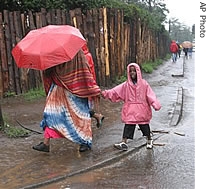2006年VOA标准英语-High Risk of Epidemics in Flood-Stricken Horn o(在线收听)
By Lisa Schlein
Geneva
08 December 2006
U.N. aid agencies are stepping up humanitarian assistance to three flood-stricken countries in the Horn of Africa. The agencies are warning the risk of epidemics breaking out in Ethiopia, Kenya and Somalia is very high. Lisa Schlein reports for VOA from the United Nations European headquarters in Geneva.
 |
| A Kenyan woman and her child walk in the rain in the Kibera slum in Nairobi, Kenya (File) |
The floods have caused hundreds of deaths, massive displacement and considerable damage to livelihoods.
The World Health Organization warns the flooding is putting people's health at major risk. It says a combination of displacement, crowded living conditions, lack of clean, safe water and sanitation is putting up to 1.8 million people at risk of infectious diseases.
WHO Spokeswoman, Fadela Chaib, says life-threatening illnesses, especially diarrheal diseases, malaria and acute respiratory infections are of particular concern. She says cholera cases already have occurred. She says measles is a big killer of children and a large-scale immunization campaign will most likely be needed.
"The national measles vaccination coverage is really limited in the three countries. So, it is very important to have more than 80 percent vaccination among the population to avoid measles cases," she said. "If we do not have this coverage, we will likely have measles cases. And we have already had reported measles cases in Kenya."
Spokesman for the U.N. Children's Fund, Michael Bociurkiw says the water systems in the three flooded countries have been badly damaged. And, this is causing a lot of the health problems.
"You are seeing a lot of things like latrines being washed away. This causes more contamination of water systems. That is a very, very big part of our intervention to deal with water and sanitation problems," he said. "We are trucking in water. But, a lot of the roads have been washed out especially near the border with Kenya and Somalia."
In some places, Bociurkiw says the only way to bring in aid is by helicopter. He says boats and donkeys also are being used.
The U.N. refugee agency says it will start an emergency airdrop Friday of 240 tons of urgently needed relief supplies to thousands of refugees affected by the flooding in the Dadaab refugee camps in northern Kenya. This is being done with the help of a US military C-130 cargo plane. The UNHCR says 160,000 refugees in the camps, mainly from Somalia, have been cut off from aid for several weeks by the heavy rains.
Bociurkiw says the aid operation is very expensive and UNICEF urgently requires more than $24 million respond to the many needs.